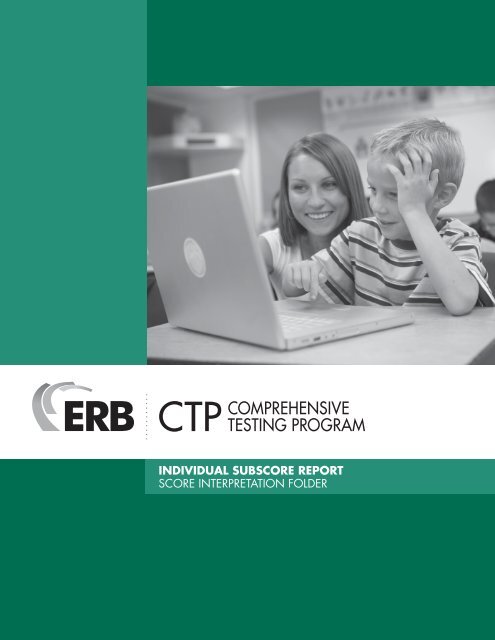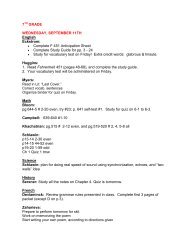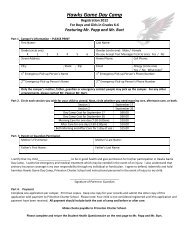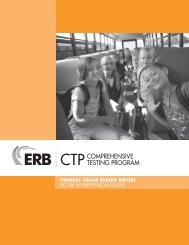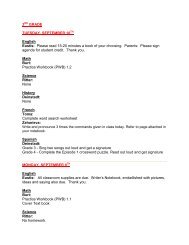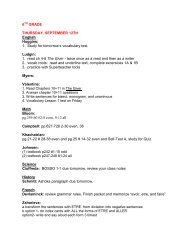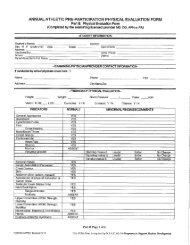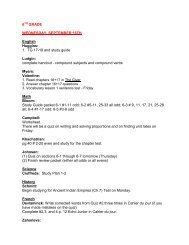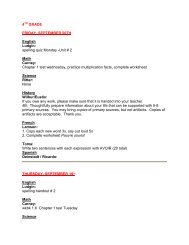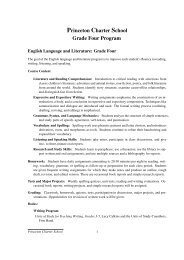INDIVIDUAL SUBSCORE REPORT SCorE INTErprETATIoN FoldEr
INDIVIDUAL SUBSCORE REPORT SCorE INTErprETATIoN FoldEr
INDIVIDUAL SUBSCORE REPORT SCorE INTErprETATIoN FoldEr
Create successful ePaper yourself
Turn your PDF publications into a flip-book with our unique Google optimized e-Paper software.
<strong>INDIVIDUAL</strong> <strong>SUBSCORE</strong> <strong>REPORT</strong><br />
<strong>SCorE</strong> <strong>INTErprETATIoN</strong> <strong>FoldEr</strong>
What does this<br />
report tell you?<br />
The Individual Subscore Report that<br />
your child’s school has given to you<br />
with this guide describes your son’s or<br />
daughter’s performance on the CTP<br />
Online tests. The report contains two<br />
kinds of information about your child:<br />
• The upper part of the report contains<br />
a table showing your child’s relative<br />
position on each test in one or more<br />
groups called “norm groups.”<br />
• The lower part of the report contains a<br />
table and a graph showing the Student<br />
Percent Mastery of Content scores<br />
that your child earned on each test<br />
and on the questions in each content<br />
category.<br />
The purpose of this guide is to explain<br />
the statistics that describe your child’s<br />
performance and to provide more<br />
information about the tests. To help<br />
you understand your child’s report, this<br />
guide includes a similar report for a<br />
fictitious student, Jessica, a fifth-grader<br />
who took the CTP Online tests in the fall<br />
of the year.<br />
WHAT IS A<br />
NORM GROUP?<br />
A norm group is a group of students with<br />
whom your child is being compared—<br />
usually other students in the same grade.<br />
The report for Jessica includes statistics<br />
that compare her performance with that<br />
of three different norm groups.<br />
• The suburban norm group consists<br />
of students in suburban public<br />
schools that use the CTP tests.<br />
For each test that Jessica took, the<br />
suburban norm group includes all<br />
the fifth-grade students in those<br />
suburban schools who took that<br />
test during the fall of the three<br />
previous years.<br />
• The independent norm group<br />
consists of students in independent<br />
schools that use the CTP tests.<br />
For each test that Jessica took, the<br />
independent norm group includes<br />
all the fifth-grade students in those<br />
independent schools who took<br />
that test during the fall of the three<br />
previous years.<br />
• The national norm group includes all<br />
the students at the appropriate grade<br />
level in all schools in the nation—<br />
large and small schools; rich and poor<br />
schools; urban, suburban, and rural<br />
schools. The statistics for the national<br />
norm group are estimates based on<br />
data from a scientifically selected<br />
sample of schools that administered<br />
the CTP 4 tests in a special “national<br />
norming” study conducted in 2002.<br />
For each test that Jessica took, the<br />
national norm group statistics<br />
are estimates that show how her<br />
performance would compare with<br />
the scores that would have resulted<br />
if all the fifth-grade students in the<br />
nation had taken that test during the<br />
fall of their fifth-grade year.<br />
WHAT IS A<br />
PERCENTILE RANK?<br />
A percentile rank is one way of<br />
comparing your child’s performance<br />
with the performance of a norm group.<br />
Your child’s percentile rank is the<br />
percentage of the norm group who had<br />
lower scores than your child (plus half<br />
the percentage who had exactly the<br />
same score as your child). A student who<br />
performed better than 70 percent of the<br />
norm group but not as well as the other<br />
30 percent would have a percentile rank<br />
of 70 in that norm group.<br />
A percentile rank does not indicate the<br />
percentage of the questions that your<br />
child answered correctly. The percentile<br />
rank is a percentage of students in<br />
a norm group. Jessica’s quantitative<br />
reasoning score had a percentile rank<br />
of 49 in the independent norm group. In<br />
other words, her quantitative reasoning<br />
score was higher than the scores of<br />
49 percent of the fifth-grade students at<br />
independent schools who took the CTP<br />
quantitative reasoning test in the fall of<br />
the three previous years.<br />
Because some norm groups perform<br />
better than others, your child’s percentile<br />
rank will differ from one norm group<br />
to another. A student’s percentile rank<br />
will be lower in a stronger norm group<br />
and higher in a weaker norm group. The<br />
students in schools using the CTP tests<br />
tend to be an academically strong group<br />
in comparison to all students in the<br />
nation. Although Jessica’s quantitative<br />
reasoning score had a percentile rank of<br />
only 49 in the independent norm group,<br />
it had a percentile rank of 88 in the<br />
national norm group.<br />
WHAT IS A STANINE?<br />
A stanine is another way of comparing<br />
your child’s performance with the<br />
performance of a norm group. Stanines<br />
are formed by dividing the students in<br />
the norm group into nine subgroups<br />
on the basis of their test scores. These<br />
subgroups are called “stanines” and are<br />
numbered 1 to 9, lowest to highest.<br />
The nine subgroups are not all the same<br />
size. The middle stanines include more<br />
students; those at the ends include<br />
fewer students. Stanine 5 is the largest;<br />
stanines 1 and 9 are the smallest. The<br />
following table shows the percentage<br />
of the students in the norm group who<br />
are in each stanine. Because these<br />
percentages are always the same, each<br />
stanine is associated with a range of<br />
percentile ranks. Those percentile ranks<br />
are also shown in the table.<br />
STANINE PERCENTAGE PERCENTILE<br />
oF STUDENTS RANKS<br />
9 4 96-99<br />
8 7 89-95<br />
7 12 77-88<br />
6 17 60-76<br />
5 20 40-59<br />
4 17 23-39<br />
3 12 11-22<br />
2 7 4-10<br />
1 4 1-3
A student in stanine 5 of a norm group has performed about as well as the average student in the norm group. In general, the<br />
middle three categories—stanines 4, 5, and 6—can be considered to represent average performance for that norm group; stanines<br />
1, 2, and 3 can be considered to represent below-average performance for that norm group; stanines 7, 8, and 9 can be considered<br />
to represent above-average performance for the norm group.<br />
Because some norm groups perform better than others, your child’s stanine can be different in different norm groups. Typically,<br />
your child’s stanine will be lower in a stronger norm group and higher in a weaker norm group. The stanine is not a very precise<br />
measure. The reason is that two percentile ranks may be very close to the borderline between one stanine and another stanine,<br />
but one may be just below the borderline and the other just at it. Before concluding that a difference between your child’s stanines<br />
on two different tests is meaningful, look at the percentile ranks. Then look at the table to see if either of the scores was nearly in a<br />
different stanine.<br />
WHAT ArE lEXIlE ® ANd QuANTIlE ® MEASurES?<br />
You may see reported Lexile and Quantile measures on your child’s report. A Lexile measure represents your child’s reading<br />
ability and can be used to match him or her with books and other materials at an appropriate difficulty level. A Quantile measure<br />
describes your child’s mathematical ability and can be used to determine his or her readiness to learn new mathematical skills<br />
and concepts. Please visit erblearn.org/ctp for more information.<br />
TESTS ANd CATEGorIES<br />
The questions on each CTP Online test are classified<br />
into “content categories” on the basis of the skills that<br />
they measure. The lower part of the report shows your<br />
child’s performance on each test as a whole and on<br />
each content category in the test. The numbers at the<br />
left indicate the Student Percent Mastery of Content<br />
your child earned.<br />
What is a Student Percent Mastery of Content score?<br />
It looks like a percent correct score but it is not. Based<br />
on a student’s performance and the characteristics<br />
of the items answered correctly, it is an estimate of<br />
the percentage of items a student would get correct if<br />
he or she could take all items in a particular content<br />
area. Student Percent Mastery of Content scores<br />
have a higher degree of reliability compared to<br />
percent correct scores because the Percent Mastery of<br />
Content scores are based on both the characteristics<br />
of the items answered correctly and the student’s<br />
performance level.<br />
The bar graph compares your child’s performance<br />
with the average performance of the students in one<br />
of the norm groups–either the suburban public school<br />
norm or the independent school norm. In the graph,<br />
the black diamond indicates your child’s performance<br />
–the Student Percent Mastery of Content score that<br />
your child earned. The bar indicates the average<br />
performance of the students in the norm group.<br />
A FINAl Word<br />
Interpreting test scores can be complex. We hope<br />
we have succeeded in helping you understand the<br />
meaning of your child’s test results. If you still have<br />
any unanswered questions, the staff at your child’s<br />
school will be glad to help you.<br />
Teacher:<br />
School:<br />
Grade: 5 Level: 4<br />
Student: Jessica<br />
Individual Subscore Report<br />
Test Date: 09/10<br />
Norm: Fall<br />
The table immediately below compares the student's scores on each test with the scores of one or more "norm groups.""Percentile rank" is the percentage of students in the norm<br />
group who scored lower than this student.(It is not the same as the percentage of the questions on the test that this student answered correctly.)"Stanine" refers to a division of<br />
the norm group into nine score categories, from 1 (lowest) to 9 (highest).<br />
The graph in the lower half of the page shows the Percent Content Mastery scores by content standard. Percent Content Mastery Scores can have values between 0 and 100.<br />
These scores indicate the estimated percentage of items a student would respond to correctly if he/she could take all available items assigned to a particular content standard.<br />
Test:<br />
Norm group:<br />
Scaled Score<br />
National<br />
Norm Group<br />
%ile<br />
rank<br />
Stanine<br />
%ile<br />
rank<br />
Suburban<br />
Public Schools<br />
Stanine<br />
%ile<br />
rank<br />
Independent<br />
Schools<br />
Verbal Reasoning 331 62 6 35 4 18 3<br />
Vocabulary 348 85 7 70 6 44 5<br />
Stanine<br />
Lexile / Quantile<br />
Measure<br />
Reading Comprehension 338 69 6 46 5 27 4 960L<br />
Writing Mechanics 344 83 7 70 6 48 5<br />
Writing Concepts & Skills 341 72 6 34 4 20 3<br />
Quantitative Reasoning 340 88 7 64 6 49 5<br />
Mathematics 1&2 322 79 7 53 5 41 5 715Q<br />
Science 350 n/a n/a 83 7 83 7<br />
In the graph below: = Student Percent Mastery of Content = Norm Group : Independent Schools<br />
Tests<br />
Content Categories<br />
Verbal Reasoning 57<br />
Analogical Reasoning 50<br />
Categorical Reasoning 75<br />
Logical Reasoning 50<br />
Vocabulary 60<br />
Word Meanings 75<br />
Precision 50<br />
Application 50<br />
Reading Comprehension 66<br />
Explicit Information 67<br />
Inference 64<br />
Analysis 67<br />
Writing Mechanics 60<br />
Spelling 90<br />
Capitalization 50<br />
Punctuation 40<br />
Usage 58<br />
Writing Concepts & Skills 60<br />
Organization 60<br />
Purpose, Audience, Focus 89<br />
Supporting Details 46<br />
Style and Craft 50<br />
Quantitative Reasoning 58<br />
Comparison 56<br />
Extensions/Generalizations 67<br />
Analysis 50<br />
Mathematics 1&2 62<br />
Num. Sense & Oper. w. Whole Num. 61<br />
Num. Sense & Oper. w. Fractions & Dec. 67<br />
Geometry and Spatial Sense 67<br />
Measurement 62<br />
Data Analysis, Statistics and Prob. 63<br />
Patterns, Functions, Pre-Algebra 50<br />
Conceptual Understanding 68<br />
Procedural Knowledge 60<br />
Problem Solving 56<br />
Science 74<br />
Nature of Science 75<br />
Physical Science 67<br />
Earth Science 87<br />
Life Science 71<br />
Student Percent Mastery of Content<br />
0% 25% 50% 75% 100%<br />
Lexile ® and Quantile ® are trademarks of MetaMetrics, Inc., and are registered in the United States and abroad. Copyright © 2010 MetaMetrics, Inc. All rights reserved.<br />
Copyright © 2010 by Educational Records Bureau. All rights reserved.
Description OF CTP ONLINE TESTS<br />
Verbal Reasoning: the ability to analyze information and draw logical inferences,<br />
to recognize analogical verbal relationships, and to generalize verbal categorical attributes<br />
lEvel<br />
3-10<br />
Auditory Comprehension: prereading vocabulary and comprehension of orally presented<br />
material, understanding of stated information, the ability to determine the gist of short passages,<br />
and the ability to infer information based on these passages<br />
Vocabulary: recognition and understanding of a wide range of grade-appropriate vocabulary<br />
and use of context clues to determine meaning<br />
3<br />
4-10<br />
Reading Comprehension: comprehension of written material, including recall of information,<br />
identifying of main ideas, and hypothesizing using information from passages<br />
3-10<br />
Writing Mechanics: understanding of spelling, capitalization, punctuation, and usage conventions<br />
Writing Concepts and Skills: understanding of the components of effective written composition<br />
Mathematics: conceptual understanding of mathematics, application of mathematical<br />
knowledge to solve problems, and the ability to compute or estimate solutions<br />
3-10<br />
3-10<br />
3-10<br />
Quantitative Reasoning: the ability to analyze mathematical concepts and principles, to make<br />
generalizations, and to compare quantities mathematically<br />
3-10<br />
Algebra I: skills typically taught in Algebra I with emphasis on problem solving and operations with<br />
variables, equations, and algebraic geometry<br />
8, 9<br />
Science: understanding scientific process skills, energy, forces and motion, space systems, physical<br />
and chemical properties, the living environment and the living organism<br />
3-10<br />
MetaMetrics®, the MetaMetrics® logo and tagline, Lexile®, Lexile Framework®, Lexile Analyzer®, the Lexile® logo, Quantile®, Quantile Framework® and the Quantile® logo are<br />
trademarks of MetaMetrics, Inc., and are registered in the United States and abroad.<br />
• www.erblearn.org<br />
Copyright © 2010 by Educational Testing Service. All rights reserved.<br />
81170-023003 • Y109E.001 • Printed in U.S.A.


